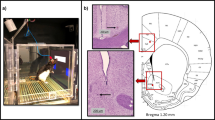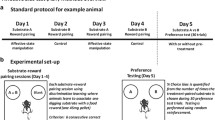Abstract
The bench-to-bedside development of pro-cognitive therapeutics for psychiatric disorders has been mired by translational failures. This is, in part, due to the absence of pharmacologically sensitive cognitive biomarkers common to humans and rodents. Here, we describe a cross-species translational marker of reward processing that is sensitive to the aminergic agonist, d-amphetamine. Motivated by human electroencephalographic (EEG) findings, we recently reported that frontal midline delta-band power is an electrophysiological biomarker of reward surprise in humans and in mice. In the current series of experiments, we determined the impact of parametric doses of d-amphetamine on this reward-related EEG response from humans (n = 23) and mice (n = 28) performing a probabilistic learning task. In humans, d-amphetamine (placebo, 10 mg, 20 mg) boosted the Reward Positivity event-related potential (ERP) component as well as the spectral delta-band representations of this signal. In mice, d-amphetamine (placebo, 0.1 mg/kg, 0.3 mg/kg, 1.0 mg/kg) boosted both reward and punishment ERP features, yet there was no modulation of spectral activities. In sum, the present results confirm the role of dopamine in the generation of the Reward Positivity in humans, and pave the way toward a pharmacologically valid biomarker of reward sensitivity across species.



Similar content being viewed by others
Data availability
All data and Matlab code to re-create these analyses are available at OpenNeuro.org, accession #ds003987.
References
Angus DJ, Kemkes K, Schutter DJLG, Harmon-Jones E (2015) Anger is associated with reward-related electrocortical activity: evidence from the reward positivity. Psychophysiology 52:1271–1280. https://doi.org/10.1111/psyp.12460
Baker TE, Holroyd CB (2011) Dissociated roles of the anterior cingulate cortex in reward and conflict processing as revealed by the feedback error-related negativity and N200. Biol Psychol 87:25–34. https://doi.org/10.1016/j.biopsycho.2011.01.010
Balsters JH, Zerbi V, Sallet J et al (2020) Primate homologs of mouse cortico-striatal circuits. Elife 9:1–24. https://doi.org/10.7554/eLife.53680
Bress JN, Foti D, Kotov R et al (2013) Blunted neural response to rewards prospectively predicts depression in adolescent girls. Psychophysiology 50:74–81. https://doi.org/10.1111/j.1469-8986.2012.01485.x
Brown DR, Cavanagh JF (2018) Rewarding images do not invoke the reward positivity: they inflate it. Int J Psychophysiol. https://doi.org/10.1016/j.ijpsycho.2018.02.012
Brown DR, Cavanagh JF (2020) Novel rewards occlude the reward positivity, and what to do about it. Biol Psychol 151https://doi.org/10.1016/j.biopsycho.2020.107841
Brown DR, Richardson SP, Cavanagh JF (2020) An EEG marker of reward processing is diminished in Parkinson’s disease. Brain Res 1727https://doi.org/10.1016/j.brainres.2019.146541
Brown DR, Jackson TCJ, Cavanagh JF (2021) The reward positivity is sensitive to affective liking. Cogn Affect Behav Neurosci. https://doi.org/10.3758/s13415-021-00950-5
Cacioppo JT, Tassinary LG (1990) Inferring psychological significance from physiological signals. Am Psychol 45:16–28
Cavanagh JF (2015) Cortical delta activity reflects reward prediction error and related behavioral adjustments, but at different times. Neuroimage 110:205–216. https://doi.org/10.1016/J.NEUROIMAGE.2015.02.007
Cavanagh JF, Bismark AW, Frank MJ, Allen JJB (2018) Multiple Dissociations between comorbid depression and anxiety on reward and punishment processing : evidence from computationally informed EEG. Comput Psychiatry. https://doi.org/10.1162/cpsy
Cavanagh JF, Gregg D, Light GA et al (2021) Electrophysiological biomarkers of behavioral dimensions from cross-species paradigms. Transl Psychiatry 11:1–11
Colquhoun D (2017) The reproducibility of research and the misinterpretation of P values. R Soc Open Sci 4:1–22. https://doi.org/10.1101/144337
Cools R (2006) Dopaminergic modulation of cognitive function-implications for L-DOPA treatment in Parkinson’s disease. Neurosci Biobehav Rev 30:1–23. https://doi.org/10.1016/j.neubiorev.2005.03.024
Cools R, Arnsten AFT (2022) Neuromodulation of prefrontal cortex cognitive function in primates: the powerful roles of monoamines and acetylcholine. Neuropsychopharmacology 47:309–328. https://doi.org/10.1038/s41386-021-01100-8
Delorme A, Makeig S (2004) EEGLAB: an open source toolbox for analysis of single-trial EEG dynamics including independent component analysis. J Neurosci Methods 134:9–21. https://doi.org/10.1016/j.jneumeth.2003.10.009S0165027003003479[pii]
Ehlers CL, Phillips E, Wills D et al (2020) Phase locking of event-related oscillations is decreased in both young adult humans and rats with a history of adolescent alcohol exposure. Addict Biol 25:1–12. https://doi.org/10.1111/adb.12732
Ehlers CL, Wills DN, Desikan A et al (2014) Decreases in energy and increases in phase locking of event-related oscillations to auditory stimuli occur during adolescence in human and rodent brain. Dev Neurosci 36:175–195. https://doi.org/10.1159/000358484
Featherstone RE, Melnychenko O, Siegel SJ (2018) Mismatch negativity in preclinical models of schizophrenia. Schizophr Res 191:35–42. https://doi.org/10.1016/j.schres.2017.07.039
Forster SE, Zirnheld P, Shekhar A et al (2017) Event-related potentials reflect impaired temporal interval learning following haloperidol administration. Psychopharmacology 234:2545–2562. https://doi.org/10.1007/s00213-017-4645-2
Foti D, Hajcak G (2009) Depression and reduced sensitivity to non-rewards versus rewards: evidence from event-related potentials. Biol Psychol 81:1–8. https://doi.org/10.1016/j.biopsycho.2008.12.004
Grilly DM, Loveland A (2001) What is a “low dose” of d-amphetamine for inducing behavioral effects in laboratory rats? Psychopharmacology 153:155–169. https://doi.org/10.1007/s002130000580
Halsey LG, Curran-Everett D, Vowler SL, Drummond GB (2015) The fickle P value generates irreproducible results. Nat Methods 12:179–185. https://doi.org/10.1038/nmeth.3288
Heydari S, Holroyd CB (2016) Reward positivity: reward prediction error or salience prediction error? Psychophysiology 53:1185–1192. https://doi.org/10.1111/psyp.12673
Holroyd CB, Krigolson OE, Lee S (2011) Reward positivity elicited by predictive cues. NeuroReport 22:249–252. https://doi.org/10.1097/WNR.0b013e328345441d
Holroyd CB, Pakzad-Vaezi KL, Krigolson OE (2008) The feedback correct-related positivity: sensitivity of the event-related brain potential to unexpected positive feedback. Psychophysiology 45:688–697. https://doi.org/10.1111/j.1469-8986.2008.00668.x (PSYP668 [pii])
Holroyd CB, Umemoto A (2016) The research domain criteria framework: the case for anterior cingulate cortex. Neurosci Biobehav Rev 71:418–443. https://doi.org/10.1016/j.neubiorev.2016.09.021
Huvermann DM, Bellebaum C, Peterburs J (2021) Selective devaluation affects the processing of preferred rewards. Cogn Affect Behav Neurosci. https://doi.org/10.3758/s13415-021-00904-x
Lakens D (2013) Calculating and reporting effect sizes to facilitate cumulative science: a practical primer for t-tests and ANOVAs. Front Psychol 4:1–12. https://doi.org/10.3389/fpsyg.2013.00863
Lueckel M, Panitz C, Nater UM, Mueller EM (2018) Reliability and robustness of feedback-evoked brain-heart coupling after placebo, dopamine, and noradrenaline challenge. Int J Psychophysiol 132:298–310. https://doi.org/10.1016/j.ijpsycho.2018.01.010
MacQueen DA, Minassian A, Kenton JA et al (2018) Amphetamine improves mouse and human attention in the 5-choice continuous performance test. Neuropharmacology 138:87–96. https://doi.org/10.1016/j.neuropharm.2018.05.034
Meyer A, Lerner MD, De Los RA et al (2017) Considering ERP difference scores as individual difference measures: issues with subtraction and alternative approaches. Psychophysiology 54:114–122. https://doi.org/10.1111/psyp.12664
Mueller EM, Burgdorf C, Chavanon ML et al (2014a) Dopamine modulates frontomedial failure processing of agentic introverts versus extraverts in incentive contexts. Cogn Affect Behav Neurosci 14:756–768. https://doi.org/10.3758/s13415-013-0228-9
Mueller EM, Burgdorf C, Chavanon ML et al (2014b) The COMT Val158Met polymorphism regulates the effect of a dopamine antagonist on the feedback-related negativity. Psychophysiology 51:805–809. https://doi.org/10.1111/psyp.12226
Mulligan EM, Hajcak G (2017) The electrocortical response to rewarding and aversive feedback: the reward positivity does not reflect salience in simple gambling tasks. Int J Psychophysiol 0–1https://doi.org/10.1016/j.ijpsycho.2017.11.015
Narayanan NS, Cavanagh JF, Frank MJ, Laubach M (2013) Common medial frontal mechanisms of adaptive control in humans and rodents. Nat Neurosci 16:1–10. https://doi.org/10.1038/nn.3549
Nolan H, Whelan R, Reilly RB (2010) FASTER: Fully Automated Statistical Thresholding for EEG artifact Rejection. J Neurosci Methods 192:152–162. https://doi.org/10.1016/j.jneumeth.2010.07.015
Pegg S, Jeong HJ, Foti D, Kujawa A (2021) Differentiating stages of reward responsiveness: Neurophysiological measures and associations with facets of the behavioral activation system. Psychophysiology 58:1–16. https://doi.org/10.1111/psyp.13764
Peterburs J, Sannemann L, Bellebaum C (2019) Subjective preferences differentially modulate the processing of rewards gained by own vs. observed choices. Neuropsychologia 132:107139. https://doi.org/10.1016/j.neuropsychologia.2019.107139
Preuss TM, Wise SP (2022) Evolution of prefrontal cortex. Neuropsychopharmacology 47:3–19. https://doi.org/10.1038/s41386-021-01076-5
Proudfit GH (2015) The reward positivity: From basic research on reward to a biomarker for depression. Psychophysiology 52:449–459. https://doi.org/10.1111/psyp.12370
Robble MA, Schroder HS, Kangas BD, et al (2021) Concordant neurophysiological signatures of cognitive control in humans and rats. Neuropsychopharmacology 1–11https://doi.org/10.1038/s41386-021-00998-4
Santesso DL, Evins AE, Frank MJ et al (2009) Single dose of a dopamine agonist impairs reinforcement learning in humans: evidence from event-related potentials and computational modeling of striatal-cortical function. Hum Brain Mapp 30:1963–1976. https://doi.org/10.1002/hbm.20642
Schaeffer DJ, Hori Y, Gilbert KM et al (2020) Divergence of rodent and primate medial frontal cortex functional connectivity. Proc Natl Acad Sci U S A 117:21681–21689. https://doi.org/10.1073/pnas.2003181117
Singer J, Willett JB (2003) Applied Longitudinal Data Analysis. Oxford University Press, Oxford
Sutton RS, Barto AG (1998) Reinforcement learning : an introduction. MIT Press, Cambridge, Mass
Threadgill AH, Gable PA (2017) The sweetness of successful goal pursuit: approach-motivated pregoal states enhance the reward positivity during goal pursuit. Int J Psychophysiol. https://doi.org/10.1016/J.IJPSYCHO.2017.12.010
Warren CM, Hyman JM, Seamans JK, Holroyd CB (2015) Feedback-related negativity observed in rodent anterior cingulate cortex. J Physiol Paris 109:87–94. https://doi.org/10.1016/j.jphysparis.2014.08.008
Webb CA, Auerbach RP, Bondy E et al (2016) Abnormal neural response to feedback in depressed adolescents. J Abnorm Psychol 126:19–31
Yu Z, Guindani M, Grieco SF et al (2022) Beyond t test and ANOVA: applications of mixed-effects models for more rigorous statistical analysis in neuroscience research. Neuron 110:21–35. https://doi.org/10.1016/j.neuron.2021.10.030
Funding
The project was funded by NIMH UH3 MH109168.
Author information
Authors and Affiliations
Contributions
JFC: Conceptualization, Methodology, Software, Formal analysis, Writing—Original Draft, Funding acquisition.
SLO: Investigation.
JAT: Investigation, Data curation, Supervision, Project Administration.
JEK: Investigation, Data curation, Supervision, Project Administration.
BZR: Investigation, Data curation, Supervision, Project Administration.
JAN: Investigation, Data curation, Supervision, Project Administration.
JS: Investigation, Data curation, Supervision, Project Administration.
DG: Investigation.
SGB: Conceptualization, Methodology, Investigation, Data curation, Supervision, Project Administration, Writing—Review & Editing, Funding acquisition.
GAL: Conceptualization, Methodology, Resources, Writing—Review & Editing, Funding acquisition.
NRS: Conceptualization, Methodology, Writing—Review & Editing, Investigation, Data curation, Supervision, Project Administration, Funding acquisition.
JWY: Conceptualization, Methodology, Writing—Review & Editing, Funding acquisition.
JLB: Conceptualization, Methodology, Resources, Writing—Review & Editing, Funding acquisition.
Corresponding author
Ethics declarations
Conflict of interest
JWY has received pharmaceutical funding from Sunovion Pharmaceuticals unrelated to the current work. All other authors report no biomedical financial interests of potential conflicts of interest.
Additional information
Publisher's note
Springer Nature remains neutral with regard to jurisdictional claims in published maps and institutional affiliations.
Supplementary Information
Below is the link to the electronic supplementary material.
Rights and permissions
About this article
Cite this article
Cavanagh, J.F., Olguin, S.L., Talledo, J.A. et al. Amphetamine alters an EEG marker of reward processing in humans and mice. Psychopharmacology 239, 923–933 (2022). https://doi.org/10.1007/s00213-022-06082-z
Received:
Accepted:
Published:
Issue Date:
DOI: https://doi.org/10.1007/s00213-022-06082-z




